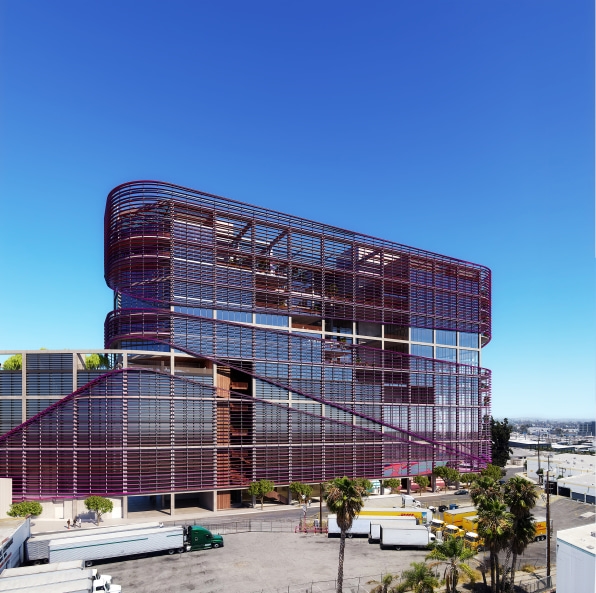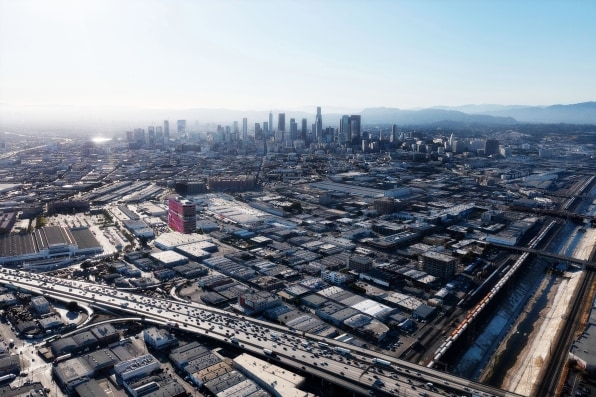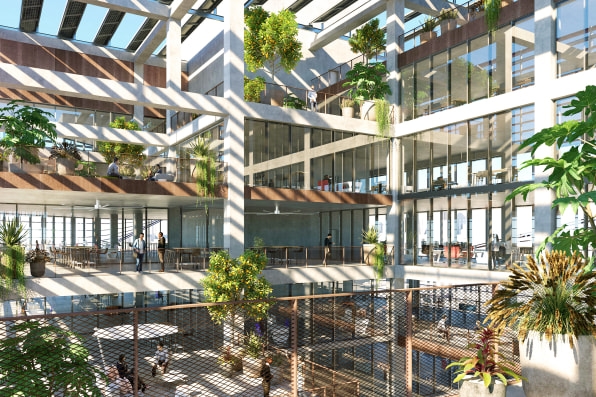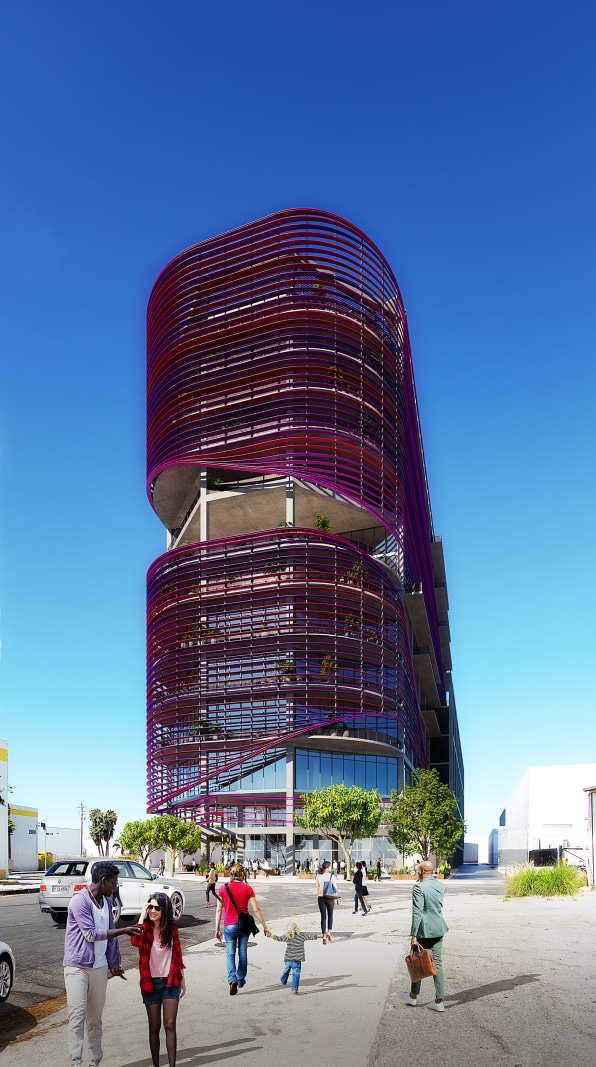This office of the future could allow you work outside year-round
By Patrick Sisson
Southern California’s often idyllic Mediterranean climate has been one factor making life in Los Angeles so expensive; many are willing to pay the premium for a drier, sunnier climate. A unique proposal for an office project in Los Angeles seeks to tap into the city’s advantageous weather and shift a significant chunk of the workspace outdoors, while challenging the notion of what’s considered “comfortable” in a world ruled by air conditioning.
The project, a ground-up high-rise development in concept for 1811 Sacramento in the Los Angeles Arts District, aims to create a more sustainable office tower by greatly increasing the amount of outdoor space leased to corporate tenants. This isn’t a case of adding additional balconies, sprucing up the green roof, or positioning a roll-up garage door to open up onto the street—all features that have become more prevalent as the indoor-outdoor space trend has reshaped the typical office in recent years.

A large portion of what would normally be enclosed offices will instead be developed as passively cooled, functional outdoor work space that will ring the building’s standard indoor office space, offering staff varying degrees of outdoor seating options during a workday. These courtyards and exterior spaces will be augmented with an array of shade structures, vegetation, and fans to make outdoor working possible almost year-round.
This won’t be your typical climate-controlled, sometimes freezing, American office. Workers will experience a greater temperature range during their workday, says Leigh Christy, principal at Perkins & Will’s LA office, which came up with the concept. An exact temperature range hasn’t been established, but it’ll be more than a typical conditioned space; design measures including shades, fans and radiant heating will help overall thermal comfort, and “fashion statements like puffy jackets and mid-afternoon popsicle breaks” may be encouraged.
“We design for a thermal comfort range, and in this space, we’re saying, why not a little bit more?” says Christy. “It’s a biophilic experience for the world we live in. It may not be for 100% of the workers, 100% of the time. It’s a huge cultural shift.”
Skanska, the developer of 1811 Sacramento, currently plans to follow a blueprint that calls for 20% of the space that typically would be enclosed to be leasable outdoor space. Tenants will be asked to pay the same amount, per square foot, for the conditioned outdoor office space. The design of the office is capitalizing on a concurrent shift in the commercial real estate market towards increasing outdoor space and decreasing a building’s carbon footprint. “We want to figure out how to tell LA to do a net zero building,” says Skanska’s Executive Vice President, Clare De Briere. “We set a pretty lofty goal, and we may not hit it, but we’ll learn a lot.”

The working premise for the developers and designers is that buildings with significantly more premium outdoor space will attract workers more accustomed to a hybrid work schedule, bring in top-tier tenants willing to pay premium rents, and cut carbon. Christy estimates that the design will cut operation costs and emissions by an estimated 20% annually.
Developed during the pandemic, 1811 Sacramento expands on many of the era’s office design trends, especially the push toward more health- and wellness-focused features and elevated workspaces that’ll tempt employees to leave the home office.
Tenants will experience private, enclosed, wired outdoor workspace, aiming to offer a better version of their experience working at home in a backyard or on a patio or balcony. It’s designed to be a step up from other contemporary office designs that are increasingly carving out new outdoor spaces–sometimes billed as air porches or garden rooms–in existing high-rises.
A veil, or scrim, that encircles the building and passively cooled outdoor spaces was designed to eliminate glare and offer passive solar protection and shade for those working inside and outside. Gaps on standard floor plates would run through the building, creating small canyons that would shade each other, further cooling the outdoor office space. Christy suggests this focus on the outdoors will push companies to change how they operate.

“??Some tenants may want to use them as collaborative spaces,and there are some scenarios where they may be more traditional workstations,” she says. “But it’s going to be a slightly different way of working, there’s no doubt.”
Will the market accept such a shift and pay the A-plus rates Skanska’s De Briere hopes to charge? (The going rate for large-scale class A offices are roughly $5.50 to $5.85 a square foot a month.) Like many other cities, L.A. has seen offices in or near central business districts become increasingly vacant; recent research from Colliers found the vacancy rate in downtown L.A. at 25.9% at the end of June, with both lease rates and absorption declining.
Marin Turney, an L.A.-based broker at another firm, JLL, believes there is some precedent for this kind of project. Other buildings in Los Angeles, such as FourFortyFour South Flower, have made increased outdoor space a selling point. And the Arts District submarket doesn’t have as much premium outdoor amenities right now, putting this project at an advantage.
“Absolutely it’s a desirable workplace model,” Turney says. “We’re sort of gradually hacking traditional buildings downtown to create more outdoor space.”
She does have some concerns about trying to lease a building with so much outdoor space. Tenants will need to be comfortable with their arrangment and reassured there won’t be potential security issues. And if the conditioned outdoor space requires an exceptional amount of landscaping, maintenance, and weatherproofing of outdoor furniture and workspaces, it will add considerable operational costs for the landlord.
And, of course, the weather isn’t perfect every day, even in Los Angeles: winter days, as well as increasing heat and humidity and wildfires exacerbated by climate change, can make a big bet on working outdoors seem ill-advised. “I would have apprehensions about putting in so much capital in the outdoor space and banking on rent collection on that space,” Turney adds.

Christy argues the shift toward working outside won’t feel like as big a leap for tenants, due in part to a design focused on increasing shade and airflow. Research suggested workers would be able to use the outdoor space comfortably on roughly 95% of workdays.
“What we’re hearing from brokers is that, obviously, commercial real estate is challenging right now,” she says. “But what we’ve also been hearing is that this is the kind of space people are looking for. It is a little bit of a leap of faith. But it’s a leap of faith based on the market.”
(17)



